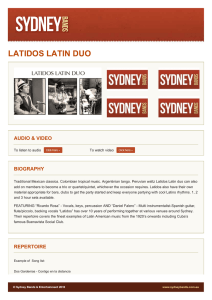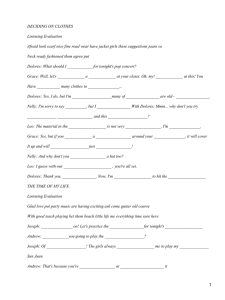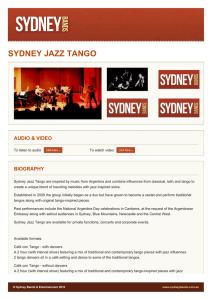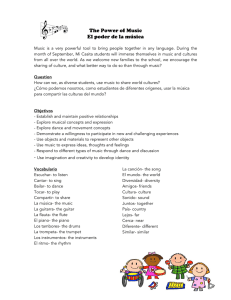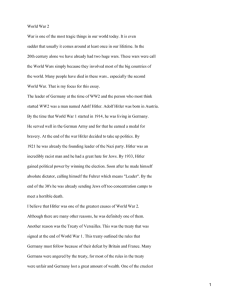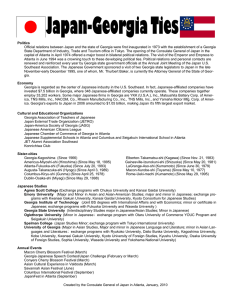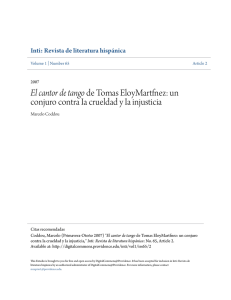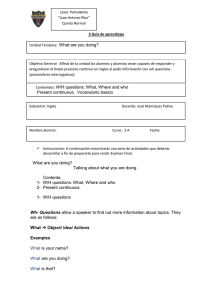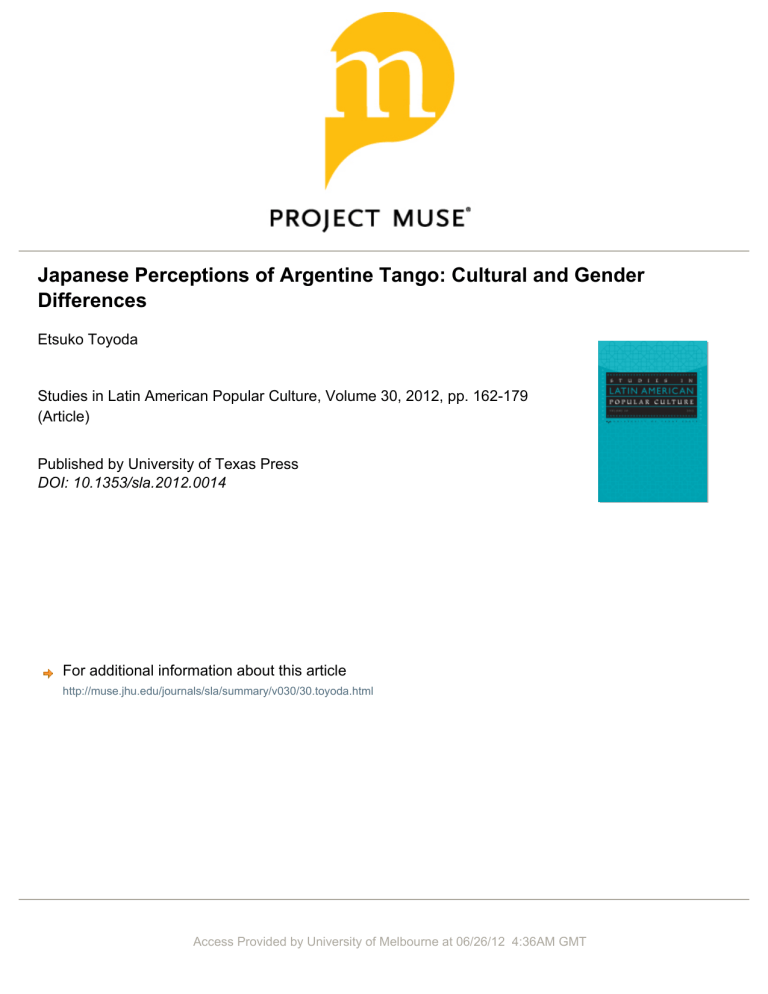
Japanese Perceptions of Argentine Tango: Cultural and Gender Differences Etsuko Toyoda Studies in Latin American Popular Culture, Volume 30, 2012, pp. 162-179 (Article) Published by University of Texas Press DOI: 10.1353/sla.2012.0014 For additional information about this article http://muse.jhu.edu/journals/sla/summary/v030/30.toyoda.html Access Provided by University of Melbourne at 06/26/12 4:36AM GMT Japanese Perceptions of Argentine Tango: Cultural and Gender Differences Etsuko Toyoda The University of Melbourne Dance of Passion I n Argentina and Uruguay, the tango, the dance of passion, is a deeprooted tradition, closely related to the history of the region, and maintained for decades by aficionados. In October 2009, the tango (widely known as the Argentine tango) was recognized by the United Nations as part of the world’s intangible cultural heritage (UN News n. pag., par. 1). This study investigates gender and cultural differences in perceptions about the Argentine tango danced by the Japanese and Latin Americans (hereafter “Latinos”). While the dance cannot be separated from the music, my focus is the dance. In this article the term tango refers to the Argentine tango dance, unless otherwise specified. The findings of my study suggest that, despite the clear division of roles, the female and male dancers’ perceptions are very similar. On the other hand, despite the tango’s long history and popularity in Japan, there are significant differences between the two cultural groups, the Japanese and Latin Americans, in their perceptions of the tango. Gender Settings In the Argentine tango, the roles played by the male dancer and female dancer are distinct. The male invites a woman to dance, embraces her, and confidently leads by listening to and interpreting the music, and improvising steps to suit (Takahashi 91). During the dance, the male dancer is also required to create a peaceful, protective, and enjoyable environment for his partner while navigating across the floor. The woman accepts (or ignores) the invitation and returns the embrace. She is calm but alert so as to sense the male dancer’s marca (this usually involves an indication of the direction of the next step, but may include the direction of rotation, pauses, stops, timing changes, change of axis, and even passage of control from male to female). She then makes appropriate responses (in three dimensions and time) to the marca. Studies in Latin American Popular Culture, Vol. 30, 2012 © 2012 by the University of Texas Press, PO Box 7819, Austin, TX 78713–7819 Etsuko Toyoda 163 The gender roles in the tango are seen by Elshaw to reflect Argentine cultural values such as machismo (manliness): To be macho the Argentinean way is to be self confident, to be certain of where a man stands and where he is going. He is in charge, he is reliable and accepts responsibility. He cares for the well-being, safety and happiness of his woman. (Elshaw n. pag., par. 3) Although the responsibilities of female dancers are fewer compared to their male partners, the female role is certainly not passive. Olszewski claims that the role women play in the tango is also a reflection of the Argentine culture, of the strong social norms that differentiate roles according to gender (75). The woman/mother/housewife is in charge of domestic work, and the man supplies the income for the family’s maintenance (Jelin 193). While machismo is valued, a woman’s role in society is no less valued. For this reason, tanguearas, or female tango dancers, are tough, assertive, creative, and autonomous, both in their dance and in their selection of partners (Olszewski 75). Thus, the tango is often described as “four legs, two heads, and one heart.” Although the man and woman have different responsibilities, they dance as one, actively collaborating in the creation of an ephemeral dance experience (Olszewski 71). Cultural Settings Japan first encountered the tango as part of elegant French-style ballroom dance in the 1920s (Savigliano 239). At that time, the tango was a dance of the elite (Gambarotta n. pag., par. 3). By the 1930s, middle-class Japanese had access to the British-style ballroom tango (Savigliano 240). Even during World War II when almost all pleasure was banned, listening to tango music was possible (Savigliano 243). After the war, a circle of tango lovers organized regular gatherings to listen to tango music and, to a lesser extent, dance to it, by copying the Argentine dancers seen on films (Miura 22). As far as the general public was concerned, the key to the dissemination of the tango was the stage show “Tango Argentino,” which opened in Paris in 1983 (Goertzen and Azzi 68), toured the world, and created an Argentine tango boom in Europe, North America, and Japan in the late 1980s (Takahashi 23; Manus n. pag., par. 8). Today there are numerous classes and milongas, or dance parties, held in dance halls all over Japan. Despite the long history, until the late 1980s most Japanese dancers did not have opportunities to see Latinos dance the tango live. When a pioneer tango instructor, Kobayashi, started to teach the tango in Japan after having studied it in Buenos Aires, people were initially very reluctant to embrace 164 Studies in Latin American Popular Culture their partners, since showing affection in public was considered to be embarrassing (n. pag., par. 13). Today, tango students learn the authentic Argentine tango, including the display of passion and sensuality, from Argentine teachers who are visiting or living in Japan and/or Japanese teachers who were trained in Buenos Aires. They also have abundant opportunities to see performances by Argentine tango dancers and Japanese dancers who have learned the dance from Argentine maestros. Nevertheless, Takahashi (25) claims that many Japanese people dance the tango aesthetically but without sentiment, attributing this tendency to the influence of Confucian ethics according to which Japanese people do not openly show their emotions (Takahashi 99). Savigliano maintains that “when Japanese perform the Argentine tango, incorporating all the techniques of passion they have learned from Argentine performers, they still look Japanese” (248). Contrary to the surface difference, some Japanese tango dancers emphasize the kinship between the Japanese and Argentinean cultures by pointing out their common sentimental and melancholic nature (Savigliano 245), and many believe in a special compatibility between the national psyches of Japan and Argentina (Goertzen and Azzi 71). Survey This survey aims to identify gender and cultural differences between Latin Americans and Japanese in how they dance the tango. A web-based survey with one hundred tango-related key words is used to investigate perceptions of the dance. Participants of the survey are volunteers who have responded to my online invitation to tango dance schools and individual tango teachers in Japan and in Argentina and its neighboring countries, and to tango-related websites and relevant mailing lists. The final participant group consists of seventy-three tango dancers, comprising, by gender, forty-two females, thirty males, and one unknown; and, by culture, thirty-nine Japanese and thirtyfour Latinos. Gender and culture are classified according to responses to questions in the survey. In the gender question, survey respondents click on a point on a band with male or female at either end. For cultural identity, each participant chooses the culture most influential in their character development, since citizenship, blood, language, or ethnicity alone can no longer determine one’s culture (Mouer 121). The target culture, against which the Japanese culture is compared, has been widened from the Argentine to the Latino culture for two reasons. Firstly, the tango has permeated Argentina, Uruguay, and neighboring countries, and secondly, the Latin American countries share relatively homogeneous values and behaviors despite their minor differences (Nakagawa 40). Etsuko Toyoda 165 The survey is web-based, it being a time- and cost-efficient method when participants are in various parts of the world, and is in two languages, Japanese and Spanish, from which participants can choose. Translations of the words have been checked by one Japanese native speaker with some knowledge of Spanish, one Spanish native speaker, and one Japanese-Spanish bilingual speaker. The survey uses 100 words selected from an initial pool of 172 words appearing in books and journal articles in the fields of tango dancing, Argentine culture, and Japanese culture. The list of words has been reduced to one hundred by removing less frequently appearing words in order to avoid possible fatigue effects. The first section of the survey has some questions designed to obtain background information about the participants. The second half has one hundred words displayed one at a time in random order (in order to avoid any presentation sequence effect). The participants are required to judge how much each word is important to their tango, in the range of unimportant to very important (0–5). While there is no time limit imposed, the aim is for judgments to be based on intuition (without deep thought); the suggestion being that each word should take no more than six seconds, so that the survey can be completed in about ten minutes. The participants’ responses are automatically recorded on the web server. The data set includes only valid responses (i.e., all one hundred words completed). Any individual’s responses where the rating of importance is constant across many contiguous words are not included in the final data set, as they could be ill-considered responses. To compare the differences between female and male groups, and between Japanese and Latino groups, independent t-tests are conducted. P-value is set at 0.05. After the statistical analysis of the results of the survey, the findings are interpreted and explained, firstly within each aspect of the findings and secondly within the spectrum of discourse theory. Results of the One-Hundred-Word Survey The breakdown of the participants is shown in the following tables (tables 1 and 2). Both the gender groups (i.e., Japanese and Latino males and Japanese and Latino females) rate the following words as important (M ⱖ 4): Aesthetic, Authentic, Connective, Creative, Emotional, Emotionally Touching, Harmony, Inspiring, Intuitive, Passionate, Pleasurable, Respectful, Satisfaction (see table 3). A significant gender difference is found in one word only: Inspiring. The male group rates this word significantly more highly than does the female group (Female M ⫽ 4.1, SD ⫽ 0.92; Male M ⫽ 4.5, SD ⫽ 0.68; conditions t(70) ⫽ 1.99, p ⫽ 0.05). 166 Studies in Latin American Popular Culture Table 1: Participant Summary, Female and Male Groups Female group (n ⴝ 42) Male group (n ⴝ 30) Culture Japanese Latino 27 (64%) 15 (36%) Japanese Latino 11 (37%) 19 (63%) Age 40 or younger 41 or older 25 (60%) 16 (38%) 40 or younger 41 or older 11 (37%) 19 (63%) Occupation (top 3) Dance Arts Business Education Health 11 (26%) 6 (14%) 4 (10%) 4 (10%) 4 (10%) Dance Architecture Business Info technology 11 (37%) 4 (13%) 3 (10%) 3 (10%) Tango Experience 10 yrs or more Less than 10 yrs 14 (33%) 28 (67%) 10 yrs or more Less than 10 yrs 13 (43%) 16 (53%) Tango Frequency Almost everyday Less 12 (29%) 30 (71%) Almost everyday Less 15 (50%) 14 (47%) Reasons for tango (top 3) 29 (69%) Love dancing Love tango music 29 (69%) Want to improve 23 (55%) Love tango music Love dancing Want to improve 22 (73%) 16 (53%) 12 (40%) Occupation Architecture ⫽ Architecture/Building/Landscape Arts ⫽ Arts/Design/Entertainment/Mass communication Business ⫽ Business management /Admin. Services Dance ⫽ Dancer/Dance education Education ⫽ Education/Training/Child development Health ⫽ Health/Medicine Info technology ⫽ Information technology The female group rates the words Comfortable, Integrated, Responsive, and Trusting highly as well. Although the means of the male group for these words are lower than those of the female group, the differences are not significant (see table 4). The words chosen by the male group as important to the tango are Confidence, Enchanting, Intimate, Liberated, Loving, Natural, Relaxing, Romantic, Sensual and Sincere. Although the means of the female group for these words are slightly lower, there are no significant differences between the two gender groups except for the words Liberated and Romantic (see table 5). In these two words, the means of the male group are significantly higher than those of the female group (Liberated: Female M ⫽ 3.3, SD 1.33; Male M ⫽ 4.1, SD ⫽ 1.00; conditions t(70) ⫽ 2.92, p ⬍ 0.05); Romantic: Etsuko Toyoda 167 Table 2: Participant Summary, Japanese and Latino Groups Japanese group (n ⴝ 39) Latino group (n ⴝ 34) Gender Female Male 27 (69%) 11 (28%) Female Male 14 (41%) 20 (59%) Age 40 or younger 41 or older 18 (46%) 20 (51%) 40 or younger 41 or older 18 (53%) 16 (47%) Occupation (top 3) Dance Health Business Economics Education Info technology 10 (26%) 4 (10%) 3 (8%) 3 (8%) 3 (8%) 3 (8%) Dance Art Business 12 (35%) 5 (15%) 4 (12%) Tango Experience 10 yrs or more Less than 10 yrs 10 (26%) 28 (72%) 10 yrs or more Less than 10 yrs 18 (53%) 16 (47%) Tango Frequency Everyday/Almost 12 (31%) Less 26 (67%) Everyday/Almost Less 15 (44%) 19 (56%) Reasons for tango (top 3) Tango Music Love dancing Want to improve Love dancing Tango Music Want to improve 22 (65%) 21 (62%) 12 (35%) 30 (77%) 24 (62%) 23 (59%) Arts ⫽ Arts/Design/Entertainment/Mass communication Business ⫽ Business management /Admin. Services Dance ⫽ Dancer/Dance education Economics ⫽ Economics/Finance Education ⫽ Education/Training/Child development Health ⫽ Health/Medicine Info technology ⫽ Information technology Female M ⫽ 3.6, SD ⫽ 1.17; Male M ⫽ 4.2, SD ⫽ 1.00; conditions t(70) ⫽ 2.39, p ⬍ 0.05). For the cultural groups (Japanese and Latino), the words that are regarded as important (M ⱖ 4) by both are Authentic, Connective, Creative, Emotional, Harmony, Inspiring, Intimate, Intuitive, Passionate, Pleasurable, Respectful, and Satisfaction (see table 6). There are no significant differences in the means of all these words. There are many more words that the Japanese participants judge as important (M ⱖ 4): Adaptive, Aesthetic, Alert, Comfortable, Emotionally Touching, Enchanting, Euphoric, Feminine, Individualistic, Integrated, Loving, Natural, Relationship, Romantic, Sophisticated, Spiritual, and Trusting. Significant cultural differences are found in some of these words (see table 7). Table 3: Words Chosen as Important to Their Tango by Both Female and Male Groups (Mean Rate 4 or Above) Female (n ⴝ 42) Male (n ⴝ 30) Mean SD Mean SD Sig. Diff. Aesthetic 4.0 1.13 4.3 0.91 No Authentic 4.0 1.46 4.5 0.78 No Connective 4.3 0.94 4.1 1.06 No Creative 4.3 0.95 4.2 1.01 No Emotional 4.1 1.02 4.0 1.00 No Emotionally touching 4.1 1.21 4.1 1.07 No Harmony 4.2 1.02 4.3 0.79 No Inspiring 4.1 0.92 4.5 0.68 t(70) ⫽ 1.99 Intuitive 4.1 1.08 4.1 1.20 No Passionate 4.2 0.88 4.4 0.82 No Pleasurable 4.3 0.94 4.1 1.28 No Respectful 4.2 1.21 4.4 1.13 No Satisfaction 4.2 0.90 4.4 0.86 No Words Table 4: Words Chosen as Important to Their Tango by Female Group Only Female (n ⴝ 42) Male (n ⴝ 30) Mean SD Mean SD Sig. Diff. Comfortable 4.1 1.32 3.9 1.73 No Integrated 4.0 1.24 3.9 1.22 No Responsive 4.0 1.17 3.6 1.57 No Trusting 4.1 1.23 3.9 1.46 No Words Table 5: Words Chosen as Important to Their Tango by Male Group Only Female (n ⴝ 42) Male (n ⴝ 30) Mean SD Mean SD Sig. Diff. Confidence 3.8 1.24 4.0 1.15 No Enchanting 3.9 1.25 4.1 1.29 No Intimate 3.9 1.03 4.3 0.84 No Liberated 3.3 1.33 4.1 1.00 t(70) ⫽ 2.92 Loving 3.7 1.33 4.1 1.14 No Natural 3.8 1.25 4.3 1.05 No Relaxing 3.8 1.21 4.1 1.14 No Romantic 3.6 1.17 4.2 1.00 t(70) ⫽ 2.39 Sensual 3.6 1.27 4.2 1.05 No Sincere 3.6 1.45 4.1 1.29 No Words Table 6: Words Chosen as Important to Their Tango by Both Japanese and Latino Groups Japanese (n ⴝ 39) Words Latino (n ⴝ 34) Mean SD Mean SD Sig. Diff. Authentic 4.0 1.31 4.4 1.11 No Connective 4.1 0.95 4.2 1.05 No Creative 4.3 0.90 4.2 1.05 No Emotional 4.1 0.90 4.0 1.11 No Harmony 4.2 0.96 4.2 0.91 No Inspiring 4.4 0.75 4.1 0.92 No Intimate 4.0 0.97 4.2 0.98 No Intuitive 4.1 1.09 4.0 1.18 No Passionate 4.3 0.81 4.3 0.93 No Pleasurable 4.3 0.87 4.1 1.29 No Respectful 4.4 0.90 4.1 1.41 No Satisfaction 4.2 0.90 4.3 0.88 No Table 7: Words Chosen as Important to Their Tango by Japanese Group Only Japanese (n ⴝ 39) Words Latino (n ⴝ 34) Mean SD Mean SD Sig. Diff. Adaptive 4.0 0.95 3.5 1.64 No Aesthetic 4.2 0.84 3.9 1.23 No Alert 4.1 1.00 2.7 1.73 t(71) ⫽ 4.29 Comfortable 4.4 0.87 3.5 1.90 t(71) ⫽ 2.45 Emotionally touching 4.3 0.77 3.8 1.42 No Enchanting 4.3 0.90 3.5 1.46 t(71) ⫽ 2.87 Euphoric 4.1 0.80 3.2 1.65 t(71) ⫽ 3.29 Feminine 4.1 1.10 3.2 1.84 t(71) ⫽ 2.57 Individualistic 4.1 0.97 1.2 1.20 t(71) ⫽ 11.41 Integrated 4.3 0.97 3.6 1.40 t(71) ⫽ 2.40 Loving 4.4 0.81 3.2 1.42 t(71) ⫽ 4.23 Natural 4.1 1.06 3.9 1.31 No Relationship 4.3 0.94 3.7 1.56 t(71) ⫽ 2.06 Romantic 4.1 0.90 3.5 1.31 t(71) ⫽ 2.11 Sophisticated 4.2 0.77 3.0 1.49 t(71) ⫽ 4.54 Spiritual 4.2 0.88 3.5 1.60 t(71) ⫽ 2.20 Trusting 4.3 0.96 3.6 1.56 t(71) ⫽ 2.50 Table 8: Words Chosen as Important to Their Tango by Latino Group Only Japanese (n ⴝ 39) Words Latino (n ⴝ 34) Mean SD Mean SD Sig. Diff. Confident 3.6 1.25 4.2 1.04 t(71) ⫽ 2.36 Sensual 3.7 1.10 4.1 1.28 No Etsuko Toyoda 171 The following words are regarded by the Japanese group as significantly more important than by the Latino group: Alert (Japanese M ⫽ 4.1, SD ⫽ 1.00; Latino M ⫽ 2.7, SD ⫽ 1.73; conditions t(71) ⫽ 4.29, p ⬍ 0.05); Comfortable (Japanese M ⫽ 4.4, SD ⫽ 0.87; Latino M ⫽ 3.5, SD ⫽ 1.90; conditions t(71) ⫽ 2.45, p ⬍ 0.05); Enchanting (Japanese M ⫽ 4.3, SD ⫽ 0.90; Latino M ⫽ 3.5, SD ⫽ 1.46; conditions t(71) ⫽ 2.87, p ⬍ 0.05); Euphoric (Japanese M ⫽ 4.1, SD ⫽ 0.80; Latino M ⫽ 3.2, SD ⫽ 1.65; conditions t(71) ⫽ 3.29, p ⬍ 0.05); Feminine (Japanese M ⫽ 4.1, SD ⫽ 1.10; Latino M ⫽ 3.2, SD ⫽ 1.84; conditions t(71) ⫽ 2.57, p ⬍ 0.05); Individualistic (Japanese M ⫽ 4.1, SD ⫽ 0.97; Latino M ⫽ 1.2, SD ⫽ 1.20; conditions t(71) ⫽ 11.41, p ⬍ 0.05); Integrated (Japanese M ⫽ 4.3, SD ⫽ 0.97; Latino M ⫽ 3.6, SD ⫽ 1.40; conditions t(71) ⫽ 2.40, p ⬍ 0.05); Loving (Japanese M ⫽ 4.4, SD ⫽ 0.81; Latino M ⫽ 3.2, SD ⫽ 1.42; conditions t(71) ⫽ 4.23, p ⬍ 0.05); Relationship (Japanese M ⫽ 4.3, SD ⫽ 0.94; Latino M ⫽ 3.7, SD ⫽ 1.56; conditions t(71) ⫽ 2.06, p ⬍ 0.05); Romantic (Japanese M ⫽ 4.1, SD ⫽ 0.90; Latino M ⫽ 3.5, SD ⫽ 1.31; conditions t(71) ⫽ 2.11, p ⬍ 0.05); Sophisticated (Japanese M ⫽ 4.2, SD ⫽ 0.77; Latino M ⫽ 3.0, SD ⫽ 1.49, conditions t(71) ⫽ 4.54, p ⬍ 0.05), Spiritual (Japanese M ⫽ 4.2, SD ⫽ 0.88; Latino M ⫽ 3.5, SD ⫽ 1.60; conditions t(71) ⫽ 2.20, p ⬍ 0.05); Trusting (Japanese M ⫽ 4.3, SD ⫽ 0.96; Latino M ⫽ 3.6, SD ⫽ 1.56; conditions t(71) ⫽ 2.50, p ⬍ 0.05). On the other hand, only two words are regarded as important by the Latin group (M ⱖ 4) but not by the Japanese group (M ⬍ 4): Confident and Sensual (see table 8). The difference is significant for Confident (Japanese M ⫽ 3.6, SD ⫽ 1.25; Latino M ⫽ 4.2, SD ⫽ 1.04; conditions t(71) ⫽ 2.36, p ⬍ 0.05), but not for Sensual. Interpretation As the well-known expression goes, “It takes two to tango.” The tango requires two partners, in the normal case a man and a woman. However, the roles they take in dancing are distinct. The man needs to interpret the music and improvise the dance (Takahashi 91). He has to lead the dance flawlessly while navigating across a crowded dance floor (Elshaw n. pag., par. 9). The woman usually closes her eyes, feels the music and the lead, and moves accordingly (Takahashi 91; see Chang n. pag., par. 7 for a personal account). Despite the division of roles, the female and male dancers’ responses to the survey are very similar. Significant gender differences are found in only three words, as is explained below. While both males and females judge the word Inspiring as very important, the male dancers rate it significantly more highly than do female dancers. It appears that the Argentine tango inspires both men and women, but 172 Studies in Latin American Popular Culture the impact is greater on men. There is a plausible reason why male dancers feel more deeply inspired. In dancing the tango, the partners dance without predefined choreography (Takahashi 91). The music inspires the male dancer (Elshaw n. pag., par. 9), and the music and the marca (indicating the direction of the next step) inspire the woman, and together they create a dance (Olszewski 69), which may be a very inspiring experience for both parties. However, while the woman can easily be oblivious to everything but the dance, the man has to be attentive not only to his dance and his partner but also to other people dancing around him (Elshaw n. pag., par. 9). Given this “multitasking” and the responsibility of leading, it is not surprising that male dancers find the successful dancing of the tango highly inspiring. The two words which male dancers judge to be significantly more important than do female dancers are Liberated and Romantic. The female dancers do not regard the concepts represented by these words as very important. On the surface, the results may seem counterintuitive. In fundamentally maledominated countries such as Japan and Argentina (and other Latin countries), one might think men have more freedom and more opportunities for accessing the opposite sex. However, with the increase in the status of women in those societies (Jelin 194; Kumagai 145), a much higher percentage of women now have the freedom to do something besides taking care of home and family (Christopher 109). A 2001 Japanese government survey on time use and leisure activities shows that more women than men enjoy conversations and reading magazine articles (Linhart 223). Thus women have more opportunities to experience romantic feelings through talking and reading. On the other hand, it appears that men are still expected to be macho (social stereotype) even though, in reality, they are losing their power (social phenomenon) in Japan (Kumagai 152) and Argentina (Jelin 194). In dancing the tango, men are able to feel that they can control, direct, guide, and protect women. Men can also express their emotions freely, and experience romantic feelings, without the pressure of hiding them. Pegorer hypothesizes that the Argentine tango may have become widespread because it symbolizes the image of the male-dominant (strong males looking after weak females) heterosexual relationship that many people can relate to (4). Let us now look at the cultural differences between the Japanese and Latino dancers. In Japan, the tango has a history of nearly one hundred years (Manus n. pag., pars. 3–4). It appears that the tango style has been kept as authentic as possible in Japan for many years, particularly since the 1990s when Japanese and Argentine dancers began to exchange visits, because the Japanese people usually remain extremely faithful to the original model (Hosokawa 519). In addition to this long history and authenticity of the tango, there are other factors that point to minimal cultural differences between the Japanese and Latino groups. Japaneseness has become ever harder to define with the diversification of the population of Japan through the increase in Etsuko Toyoda 173 international marriage, the naturalization of foreign-born residents, and the presence of both foreign workers (Mouer 121–22) and returnees (Japanese citizens who have returned to Japan having spent years outside the country). With respect to the differences between the Japanese and Latino cultures in particular, people in Japan nowadays have more opportunities to experience Latin people and culture, as the number of South Americans of Japanese descent, Nikkeijin, living in Japan has increased sharply since the early 1990s due to their privileged access to residential visas with no employment restrictions (Kashiwazaki n. pag., par. 4). Yet, a number of the words in the survey show significant differences between the two cultural groups. In this section, the survey results are interpreted mostly within the monocultural model. This is not to suggest a uniqueness of the Japanese culture and people. It is evident that the once-supported view that Japan is a monocultural society is one-sided (Sugimoto 1). In the mid-twentieth century, the popular view was that each society possesses a unique culture, and Japan was described and analyzed within the discourse of Japaneseness (Befu 25), which ignored diversity within the society. With the force of globalization, Japan has become a society of cultural diversity. However, it is also true, as Sugimoto emphasizes, that the two models (monocultural and multicultural) coexist in rivalry rather than one completely overwhelming the other (Sugimoto 3). The differences between the responses of the Japanese and Latino groups tend to highlight the uniqueness of the Japanese society and culture. The Japanese participants rate the following words significantly more highly than do the Latino participants: Comfortable, Enchanting, Euphoric, Spiritual, Sophisticated, and Individualistic. At a glance, although the words appear to have no relationship with each other, they may have been born out of the same expectation, which is an escape from day-to-day stresses. Considerable stresses exist in the competitive schools and workplaces of Japan (Christopher 94). From childhood, Japanese students listen to the teacher and study hard as instructed, and try to get better results than others (Christopher 89). As grown-ups, employees work hard to outachieve others (Takahashi 150). On the other hand, those who are not active in the front lines may suffer from feelings of defeat and inferiority. In either case, people are under great stress, which often causes a somewhat depressed mood. In extreme cases, their “leisure time” could also be under stress, as some workers, for economic reasons, spend their holidays in the leisure facilities that their companies provide (Linhart 231). The tango could be an escape for these people. The film Shall We Dansu? (directed by Masayuki Suo), which was about a successful, but weary, middle-aged “salary man” (corporate employee) who takes up ballroom dance lessons to escape from the doldrums, won thirteen Japanese Academy Awards in 1996 (Sharp n. pag., pars. 2–3), which suggests that the movie struck a chord with a considerable number of people. 174 Studies in Latin American Popular Culture Constrained human relationships are an exacerbating factor. After its introduction by China in the fifth century, Confucian ethics, which emphasizes hierarchy and loyalty, permeated Japanese society (Christopher 46; Kumagai 136), and is still deeply embedded in the Japanese people (Chu, Hayashi, and Akuto 31; Kumagai 137) in spite of the modernization of the society. One aspect of this is revealed in the exchanging of name cards. When people meet for the first time, they often exchange name cards which clearly define their group membership and status, so that both parties can obtain information on how they should treat each other (Matsumoto 9). The reason is simple. Until a Japanese person finds out someone’s group affiliation and specific position within that group, he or she is unable to decide how much deference that person should be paid (Christopher 148). In other words, people do not meet an individual; they meet a member of a certain group. At milongas, I have seen people handing out name cards with no information on their company name or position in the company. This is very peculiar in Japanese society, as usually people pay more attention to the names of organizations and positions than to people’s actual names (Itasaka 181). Thus, it is plausible that Japanese people seek an environment where they can be free of the binding stresses of social norms and expectations. The above words Comfortable, Enchanting, Euphoric, Spiritual, Sophisticated, and Individualistic may reflect the Japanese people’s suppressed desires. On the other hand, some words rated as significantly more important by the Japanese group than by the Latino group show that Japanese dancers are not totally free from Confucian ethics. The high ratings for the words Alert, Integrated, Loving, Relationship, and Trusting show that they value good relationships. The Japanese people are usually very faithful to the styles taught by masters (Takahashi 64). It is reasonable to expect that they will remain attentive and alert to the authenticity of their dancing. However, keeping their dancing authentic is not the only aspect about which they may be circumspect. They need to be alert to any breakdown in the relationship with their master, and with their dance partners, which may be caused by doing something wrong (Takahashi 64). Personal relationships are extremely important in Japan, as discussed above. It is traditional that one should not stand out, but be integrated within the group to which one belongs (Takahashi 64). This requires the love and trust of the group members. Confucianism, with its emphasis on loyalty and personal relationships, seems to be reflected in the words Integrated, Loving, Relationship, and Trusting. Feminine is one of the words that the Japanese group rate significantly more highly than do the Latino group. The central theme of the tango is the relationship of man and woman. Taylor describes the tango as “an encounter between the active, powerful, and completely dominant male and the passive, docile, and completely submissive female” (485). This image of strong males looking after weak females in the dance is parallel to the Japanese traditional image of a “yamato-onoko” (masculine man) and Etsuko Toyoda 175 “yamato-nadeshiko” (feminine woman) (Takahashi 147). Interestingly, the word Masculine, which is the antonym of Feminine, is not rated very highly (Japanese M ⫽ 3.5). This may be due to the gender imbalance in the participants: Japanese females (69 percent) versus Japanese males (28 percent). In fact, however, male participants show a tendency to regard Feminine and Masculine as important factors of the tango. The samples are too small for statistical analysis, but the mean score for Feminine in male participants is higher (Japanese male M ⫽ 4.6) than in female participants (Japanese female M ⫽ 4.0). Likewise, the mean score for Masculine in male participants is higher (Japanese male M ⫽ 4.0) than in female participants (Japanese female M ⫽ 3.3). It appears that Japanese men have a tendency to seek femininity in their female dance partners. It is plausible to relate these results to the current status of males versus females in Japanese society. While male dominance is still an overwhelming reality outside the home (Christopher 104; Shirahase 395), the image of a dominant man and a submissive woman is no doubt weakening. Japanese fathers and sons are no longer authoritarian figures (Kumagai 152). On the contrary, fathers are, in some cases, given a lower status than mothers at home, and sons are protected and guided by their mothers (Kumagai 152). This paradox of being required to be a master at work and a servant at home seems to be a great source of stress for Japanese men. It may be the case that, for male dancers, the tango evokes nostalgia for feminine charm and submissiveness. In contrast, Confident is the only one word rated significantly more highly by the Latino group than by the Japanese group. While it is natural for the experienced dancers to regard Confident as important (Latino experienced dancers M ⫽ 4.4), the less-experienced dancers are of a similar mind (Latino less-experienced dancers M ⫽ 4.0). One possible interpretation of this result is that the confidence is the product of the pride that the Argentines and Uruguayans share: pride in the tango that was born in their land and is part of their culture. Another important aspect is the image of the tango male that has been created through a long history. He is a porteño (which refers to a man living in Buenos Aires), who lives by his wits (no known source of income) but is always in control (not only of himself but all situations in which he finds himself), and can influence other people (Castro 145). This is the image that he has to present externally even if the reality is far from it. In short, the porteño is “un hombre a la defensa” (a man on guard) (Castro 146). This pride may be intertwined with the Argentines’ well-known pride in being of European descent (Matsushita 86). Due to the elimination of the indigenous population prior to the nineteenth century (Matsushita 95) and to the tide of immigrants from Europe, the majority of the population in these countries is of European descent (85 percent in Argentina and ninety percent in Uruguay according to Encyclopedia.com). As featured in an article 176 Studies in Latin American Popular Culture in the New York Times (Sims n. pag., par. 12), the Argentines and, perhaps, the Uruguayans have been very proud of their European ancestry and culture, as few of them have mixed with the indigenous inhabitants through marriage. Argentines, in particular, have also been widely regarded as arrogant (Matsushita 86), which could be a camouflage for insecurity about their real state of being among their neighboring countries (Faiola C01, par. 16). Faiola reports in the Washington Post that when Argentina, once one of the ten richest countries (Lewis 1), collapsed in the financial meltdown and was forced to face the humiliation of poverty, one of the casualties of the crisis was pride in being descended from Europeans (Faiola C01, par. 4). The tango, however, is one of the remaining aspects of their culture of which they can be proud. The value placed on Confidence may well stem from this pride. Discourse The tango is a dance created by a male dancer, who leads, and a female dancer, who follows his lead. Despite this division of roles, female and male dancers’ responses to the survey are very similar. On the other hand, despite the long history of the tango in Japan and the determination to retain the authenticity of the dance on the part of the Japanese dancers, a number of words show significant cultural differences between the Japanese and Latino dancers. These findings have been received by the members of various tango communities with surprise (personal communication with tango dancers), perhaps because the findings do not reflect their expectations which arise from the obvious differences in the roles of the male and female and the observed similarity in dance styles between the cultures. Most dancers in Japan learn the tango very diligently. They listen to their teachers’ explanations and observe their movements carefully. As a result, there are a number of dancers with advanced dancing skills (observation notes). However, it appears that the Japanese perceive the tango differently from those who acquire it in, or are strongly influenced by, the society where the tango was born and continues to flourish. This does not necessarily mean that all Latinos learn the tango at a young age; many come to it in late adulthood. What is different about them is that they are immersed in the tango from birth as it is part of the social life of Argentina and its neighboring countries (Larrain 2). Even those who do not dance it understand the heart and soul of the tango through living in the environment. On the other hand, it is not easy for Japanese dancers to grasp the deep meanings attached to the tango in the “classroom” learning environment. This may be the reason why, emotionally, the Japanese interpret the tango in their own way, which reflects their cultural values. It takes time to become acculturated to the tango culture. Etsuko Toyoda 177 Gee calls the environment in which social practices are performed “Discourse,” which is composed of people, objects, and characteristic ways of talking, acting, interacting, thinking, believing, and valuing (20). The Japanese tango dancers are apprentices of the tango Discourse, and at the same time they are members of Discourses outside of the tango (e.g., the company, school, neighborhood, or family). They face differences between the Discourse of the tango and the Discourses of Japanese society. On the other hand, the Latino tango dancers are less likely to experience this discrepancy as the tango Discourse is a part of their wider society, their environment. This may explain why the Japanese tango dancers rate so many words as important and the Latinos do not. For the Japanese dancers, the social practices in the tango are new and different (whether exciting or embarrassing). Therefore, they see a value in those things that they have not previously experienced, and in those with which they are familiar but that are not part of the new Discourse of the tango. In contrast, the Latinos do not see anything that is especially valuable, or discrepant, in the Discourse of the tango. The Discourse differences related to gender in the tango community may be less obvious due to the male dominance that is part of both the Japanese and Latino cultures and which the tango emphasizes. This may be because the societal Discourses subsume the gender Discourses. Gee explains that Discourses are tied to particular social groups and the “identities” their members take on when playing their apportioned “roles” within the social practices of the group (104). Within the Discourses of the Japanese and Latino societies there are many sub-Discourses, of which the gendered Discourse is one. Members of a Discourse are trained to think in a similar way within their mental networks. Men and women are trained to be members of respective Discourses. However, people are also members of the larger Discourses of society. The findings of the current study suggest that differences in the Discourses of gender are smaller than the differences in the Discourses of societies or cultures. While the analysis of the results of the survey reveals interesting findings, shortcomings remain. For one, the meanings of words are created within a society; for example, abstract words such as “passion” have a range of meanings according to the Discourses of that society. Deeper understanding of these meanings may be useful in designing future surveys that will reveal the cultural differences among Discourses. Works Cited Befu, Harumi. “Concepts of Japan, Japanese Culture and the Japanese.” Modern Japanese Culture. Ed. Yoshio Sugimoto. Melbourne: Cambridge UP, 2009. 21–37. Print. 178 Studies in Latin American Popular Culture Castro, Donald S. The Argentine Tango as Social History, 1880–1955—the Soul of the People. Lewiston: Edwin Mellen Press, 1990. Print. Chang, Emmeline. “The Tango Junkies—Emmeline Chang in New York.” ToTANGO. n.d. Web. 5 Jul. 2010. http://www.totango.net/emmeline.html. Christopher, Robert. C. The Japanese Mind. New York: Fawcett Columbine, 1984. Print. Chu, Godwin. C., Chieko Hayashi, and Hiroshi Akuto. “Comparative Analysis of Chinese and Japanese Cultural Values.” Behaviormetrika 22.1 (1995): 1–35. Print. Elshaw, Keith. “Tango Gender Equality.” ToTANGO. n.d. Web. 20 Jun. 2010. http://www.totango.net/equal.html. Faiola, Anthony. “Once-Haughty Nation’s Swagger Loses Its Currency.” Washington Post 13 Mar. 2002: C01. Print. Gambarotta, Lisandro. “Tango in Japan—Far East Milonga.” Eltangauta. com. n.d. Web. 14 Nov. 2009. http://www.eltangauta.com/nota.asp?id=516. Gee, James P. The Social Mind–Language, Ideology, and Social Practice. Series in Language and Ideology. Ed. Donaldo Macedo. New York: Bergim & Garvey, 1992. Print. Goertzen, Chris, and Marta S. Azzi. “Globalization and the Tango.” Yearbook for Traditional Music 31 (1999): 67–76. Print. Hosokawa, Shuhei. “Salsa no tiene frontera: orquesta de la luz and the globalization of popular music.” Cultural Studies 13.3 (1999): 509–34. Print. Itasaka, Gen. Gates to Japan—Its People and Society. Tokyo: 3A Corporation, 1986. Print. Jelin, Elizabeth. Family, Household and Gender Relations in Latin America. London: Kegan Paul; Paris: UNESCO, 1991. Print. Kashiwazaki, Chikako. “Japan’s Resilient Demand for Foreign Workers.” Migration Information Source. Washington, DC: Migration Policy Institute, 2002. Web. 1 Aug. 2010. http://www.migrationinformation.org/Feature/display.cfm?ID=8. Kumagai, Fumie. “Families in Japan: Beliefs and Realities.” Journal of Comparative Family Studies 261 (1995): 135–63. Print. Larrain, Jorge. Identity and Modernity in Latin America. Cambridge: Polity, 2000. Print. Lewis, Colin M. Argentina: A Short History. Oxford: Oneworld, 2002. Print. Linhart, Sepp. “Popular Leisure.” Modern Japanese Culture. Ed. Yoshio Sugimoto. Melbourne: Cambridge UP, 2009. 216–235. Print. Manus, Carlos. “Tsunami Megata and the rise of tango in Japan.” Todo Tango, The Academy Chronicles. n.d. Web. 5 May 2010. http://www.todotango.com/english /biblioteca/cronicas/tango_en_japon.asp. Matsumoto, David. Unmasking Japan—Myths and Realities about the Emotions of the Japanese. Stanford, CA: Stanford UP, 1998. Print. Mouer, Ross. “Work Culture.” Modern Japanese Culture. Ed. Yoshio Sugimoto. Melbourne: Cambridge UP, 2009. 113–29. Print. Olszewski, Brandon. “El cuerpo del Baile: The Kinetic and Social Fundaments of Tango.” Body and Society 14.2 (2008): 63–81. Print. Pegorer, Adriana. “Performing Gender in Milongas of Buenos Aires.” Body, Movement and Dance in Global Perspective International Conference. Hong Kong, China. 24–26 Jul. 2008. Conference Presentation. Etsuko Toyoda 179 Savigliano, Marta, E. “Tango in Japan and the World Economy of Passion.” Re-Made in Japan—Everyday Life and Consumer Taste in a Changing Society. Ed. Joseph J. Tobin. New Haven: Yale UP, 1992. 235–252.Print. Sharp, Jasper. “Shall We Dance?” Midnight Eye. Movie Review. n.d. Web. 8 Aug. 2010. http://www.midnighteye.com/reviews/shallwed.shtml. Shirahase, Sawako. “Women and Class Structure in Contemporary Japan.” British Journal of Sociology 52.3 (2001): 391–408. Print. Sims, Calvin. The World; Formerly Arrogant, Utterly Argentine.” New York Times 24 May 1998: n. pag. Print. Sugimoto, Yoshio. “‘Japanese Culture’: An Overview.” Modern Japanese Culture. Ed. Yoshio Sugimoto. Melbourne: Cambridge UP, 2009. 1–20. Print. Taylor, Julie M. “Tango.” Cultural Anthropology 2.4 (1987): 481–93. Print. UN News. “Tango Takes Its Turn on UN Cultural Body’s List of Intangible Heritage.” UN News Service. UN News Centre. 30 Sept. 2009. Web. 15 Jun. 2010. http://www.un.org/apps/news/story.asp?NewsID=32379&Cr=unesco&Cr1=. ᇣᵫᑇ (Kobayashi, Taihei). ȰɋɃȬ-ȀǠǸǻ (Essay—Toward the realisation of my dream).ȪɳɄɻɉɻɇɻȼनӮ Argentine Tango Association. Web. 19 Jun. 2010. http://www.tangodance.co.jp/Opnion/opinion1.html. ᵒϟɦɳɇ (Matsushita, Marta). “ȪɳɄɻɉɻ᭛࣪ȃ䃌Ⳍ (Various aspects of Argentine culture).” ɱɎɻȪɩɲȳ Ҏǽ⼒Ӯ (Latin America: People and Society). Eds. ЁᎱ᭛䲘 (Nakagawa, Fumio) and ϝ⬄गҷᄤ (Mita, Chiyoko) Tokyo: ᮄ䀩䂪 (Shin-Hyouron), 1998. Print. ϝ⌺ᑌϝ (Miura, Kozo). “᮹ᴀȃɇɻȼɈɻɁ (History of tango dance in Japan)”. फȪɳɄɻɉɻɇɻȼɈɻɁनӮɓɭόɁɴɇό (Shonan Argentine Tango Dance Association Newsletter) 143 (2008): 22. Print. ЁᎱ᭛䲘 (Nakagawa, Fumio). “ɱɎɻȪɩɲȳȃյ㾇ǽ㸠ࢩᾬᓣ (Latin American Values and Behaviours).” ɱɎɻȪɩɲȳ Ҏǽ⼒Ӯ (Latin America: People and Society). Ed. ЁᎱ᭛䲘 (Nakagawa, Fumio) and ϝ⬄गҷᄤ (Mita, Chiyoko). Tokyo: ᮄ䀩䂪 (Shin-Hyouron), 1998. Print. 催‟ᬓ⽎ (Takahashi, Masayoshi). ȪɳɄɻɉɻȃɇɻȼɈɻɁ (Argentine Tango Dance). Tokyo: ɪɈɻߎ⠜ (Modern Publisher), 2002. Print.
